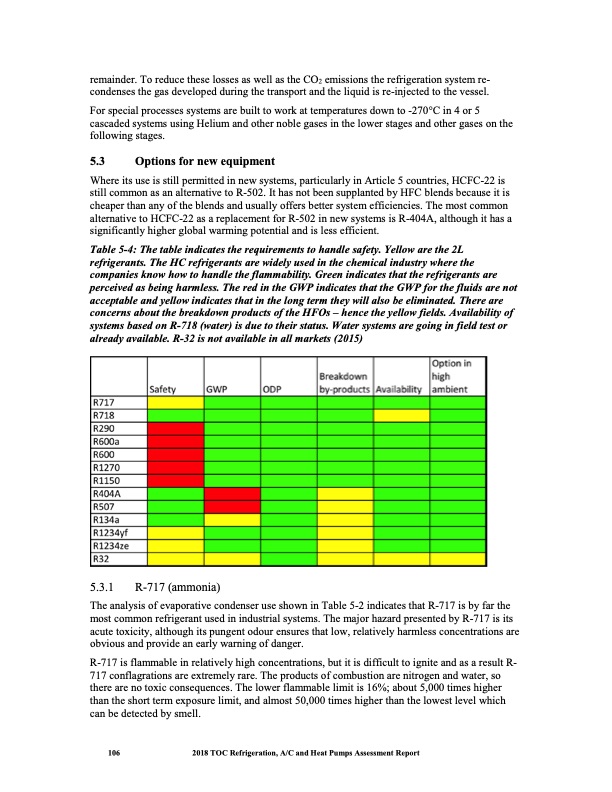
PDF Publication Title:
Text from PDF Page: 119
remainder. To reduce these losses as well as the CO2 emissions the refrigeration system re- condenses the gas developed during the transport and the liquid is re-injected to the vessel. For special processes systems are built to work at temperatures down to -270°C in 4 or 5 cascaded systems using Helium and other noble gases in the lower stages and other gases on the following stages. 5.3 Options for new equipment Where its use is still permitted in new systems, particularly in Article 5 countries, HCFC-22 is still common as an alternative to R-502. It has not been supplanted by HFC blends because it is cheaper than any of the blends and usually offers better system efficiencies. The most common alternative to HCFC-22 as a replacement for R-502 in new systems is R-404A, although it has a significantly higher global warming potential and is less efficient. Table 5-4: The table indicates the requirements to handle safety. Yellow are the 2L refrigerants. The HC refrigerants are widely used in the chemical industry where the companies know how to handle the flammability. Green indicates that the refrigerants are perceived as being harmless. The red in the GWP indicates that the GWP for the fluids are not acceptable and yellow indicates that in the long term they will also be eliminated. There are concerns about the breakdown products of the HFOs – hence the yellow fields. Availability of systems based on R-718 (water) is due to their status. Water systems are going in field test or already available. R-32 is not available in all markets (2015) 5.3.1 R-717 (ammonia) The analysis of evaporative condenser use shown in Table 5-2 indicates that R-717 is by far the most common refrigerant used in industrial systems. The major hazard presented by R-717 is its acute toxicity, although its pungent odour ensures that low, relatively harmless concentrations are obvious and provide an early warning of danger. R-717 is flammable in relatively high concentrations, but it is difficult to ignite and as a result R- 717 conflagrations are extremely rare. The products of combustion are nitrogen and water, so there are no toxic consequences. The lower flammable limit is 16%; about 5,000 times higher than the short term exposure limit, and almost 50,000 times higher than the lowest level which can be detected by smell. 106 2018 TOC Refrigeration, A/C and Heat Pumps Assessment ReportPDF Image | Heat Pumps Technical Options

PDF Search Title:
Heat Pumps Technical OptionsOriginal File Name Searched:
RTOC-assessment-report-2018_0.pdfDIY PDF Search: Google It | Yahoo | Bing
CO2 Organic Rankine Cycle Experimenter Platform The supercritical CO2 phase change system is both a heat pump and organic rankine cycle which can be used for those purposes and as a supercritical extractor for advanced subcritical and supercritical extraction technology. Uses include producing nanoparticles, precious metal CO2 extraction, lithium battery recycling, and other applications... More Info
Heat Pumps CO2 ORC Heat Pump System Platform More Info
| CONTACT TEL: 608-238-6001 Email: greg@infinityturbine.com | RSS | AMP |